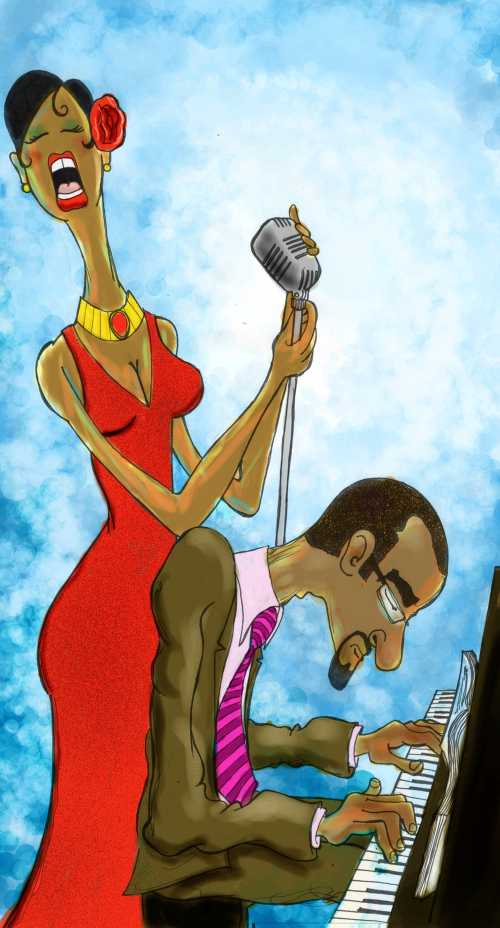PARIS, (AFP) - Can anyone beat Frederic Chopin as an emblem of the Romantic artist?

In the great Polish composer, towering genius combined with a wasted frame and a pallid face behind which lurked melancholy, a brooding over death, a
disconnection from ordinary life and sometimes horrifying hallucinations.
A force that created this image was the French novelist George Sand, who
described lyrically how her lover, cursed by prodigy and doomed by frailty to
an early grave, would be shaken by ghostly visions.
"The phantoms called him, clasped him, and instead of seeing his father and
his friend smile at him in the ray of faith, he repelled their fleshless faces from his own and struggled under the grasp of their icy hands," wrote Sand.
But a study by a pair of Spanish neurologists tarnishes this compelling gothic tableau.
Chopin's alienation and hallucinations probably had more to do with a medical condition than the burden of the Romantic artist, it suggests.
Manuel Vazquez Caruncho and Francisco Branas Fernandez of the Xeral- Calde Hospital Complex in Lugo draw this conclusion after sifting through contemporary accounts and Chopin's letters.
In 1848, at a concert at a private house in Manchester, northern England, Chopin was playing his Sonata in B flat minor when he abruptly left the room
but returned a short while later to finish the piece.
In a letter to George Sand's daughter -- which has never been published in any collection of his correspondence -- Chopin explained that he had been terrified to see "cursed creatures" emerging from the half-open case of his piano.
In other accounts by Sand and one of his pupils, Madame Streicher, Chopin was sometimes seized by a mental state that would leave him wild-eyed and his hair literally standing on end.
He himself described himself sometimes as being in a dreamy state -- in "imaginary spaces" -- and once said he felt "like steam."
The researchers look through the psychiatric states that could possibly explain the great composer's problems.
They rule out schizophrenia out because it usually takes the form of voices. Migraines can induce hallucinations, but these can last up to half an hour, whereas Chopin's episodes were brief, and lasted only a few minutes or even
seconds.
In addition, migraine auras without headache typically occur among patients over the age of 50. Chopin was only 39 when he died, of a respiratory illness.
Another psychiatric disease called Charles Bonnet syndrome is excluded, because it is linked to eye disorders, and there is no evidence that Chopin suffered from these.
Chopin did take opium, in the form of a tincture called laudanum, to ease his many physical problems. But the type of hallucinations he had do not correspond to opium-related visions -- and he experienced them years before
taking the opium.
This leaves one big suspect: epilepsy of the temporal lobes, whose seizures can unleash brief, stereotyped visions of the kind experienced by Chopin and a condition called "jamais vu," or a dream-like disconnection from one's
surroundings.
But the patient is not drowsy, nor does he lose a state of consciousness.
The authors point out that epilepsy was poorly understood in Chopin's day and could easily have been overlooked by his doctors, although they freely admit that this is only a "diagnostic guess."
Even so, it "could help to separate romanticised legend from reality and shed new light in order to better understand the man and his life," they say.
The study is published on Monday in Medical Humanities, a journal of the British Medical Association (BMA).
<한글 기사>
"낭만주의자 쇼팽의 '환각'은 간질 때문"
스페인 신경학자, 논문서 주장
(파리 AFP.블룸버그=연합뉴스) 허약한 체격에 창백한 얼굴, 죽음을 사색하는 듯 한 우울한 분위기의 천재 음악가.
서정적인 음악으로 '피아노의 시인'으로 불리는 작곡가 프레데리크 쇼팽(1810~1849)은 이런 이미지로 대중들에게 '낭만적 예술가'로 인식돼왔다.
쇼팽과 미묘한 사랑을 나눴던 19세기 프랑스 낭만파 여류작가인 조르주 상드(1804~1876)는 연하의 애인에 대한 이미지를 서정적으로 묘사하며 때로는 환각에 시달리던 모습도 그렸다.
상드는 "유령들이 그를 불러 움켜잡았고, 그는 아버지와 친구들의 웃는 얼굴을 바라보는 대신 핼쑥한 얼굴들(유령들)을 쫓아내고 그들의 차가운 손에 붙잡혀 싸워야 했다"고 적었다.
스페인 루고주(州) 소재 제랄칼데 병원의 신경학자인 마누엘 바즈쿠에즈 카룬초와 프란시스코 브라나스 페르난데스는 25일 발표한 논문에서 쇼팽의 이러한 정신이상과 환각 증세가 간질과 관계 있다는 의학적 소견을 내놓았다.
자신들의 의학적 지식과 쇼팽의 편지 등을 검토한 결과 쇼팽의 실제 기괴한 모습을 낭만적 예술가의 이미지로만 결부시켜서는 안 된다는 결론을 얻었다는 것이다.
1848년 영국 맨체스터의 한 저택에서 자신의 소나타 작품을 연주하던 쇼팽은 갑자기 장소를 떠나더니 잠시 후 돌아와 연주를 끝냈다.
상드의 딸에게 보낸 비공개 편지에서 쇼팽은 당시 반쯤 열린 피아노에서 '저주 받은 창조물'이 나타나 두려움에 떨었다고 고백했다.
상드와, 쇼팽의 제자들도 쇼팽이 종종 몽롱한 눈빛을 하고서는 머리카락도 쭈빗 쭈빗 선 상태를 보였다고 말한 것으로 전해졌다.
쇼팽 자신도 때때로 꿈꾸는 듯한 상태에서 마치 현실과는 다른 상상의 공간에 있는 듯하다며 한번은 마치 증기(steam)와 같은 느낌이었다고 말한 적도 있다.
두 신경학자는 쇼팽이 이런 상태로 지속되는 시간이 몇 분에 불과할 정도로 극히 짧았다는 점에서 정신분열증은 아니며, 측두엽 간질일 가능성이 크다고 추정했다
이들은 측두엽 간질은 시각적 환영 증세를 나타낸다며 "쇼팽이 살았던 당시에는 이 질병이 잘 알려지지 않았기 때문에 그의 주치의가 지나쳤을 수 있다"며 쇼팽이 숨지기에 앞서 적어도 12년 전 환영 증세가 시작됐을 것이라고 말했다.
이들은 자신들의 의견은 그저 의학적 소견이지만 "쇼팽을 (그가 겪은) 현실과는 달리 낭만적으로 묘사된 전설의 인물로만 보지 말고 그의 삶을 더 잘 이해하는데 단서가 되기를 바란다"고 덧붙였다.
이번 연구결과는 영국의학협회(BMA) 저널의 의료 인문학 분야에 게재된다.

















![[KH Explains] Hyundai's full hybrid edge to pay off amid slow transition to pure EVs](http://res.heraldm.com/phpwas/restmb_idxmake.php?idx=652&simg=/content/image/2024/04/18/20240418050645_0.jpg&u=20240418181020)

![[Today’s K-pop] Zico drops snippet of collaboration with Jennie](http://res.heraldm.com/phpwas/restmb_idxmake.php?idx=642&simg=/content/image/2024/04/18/20240418050702_0.jpg&u=)